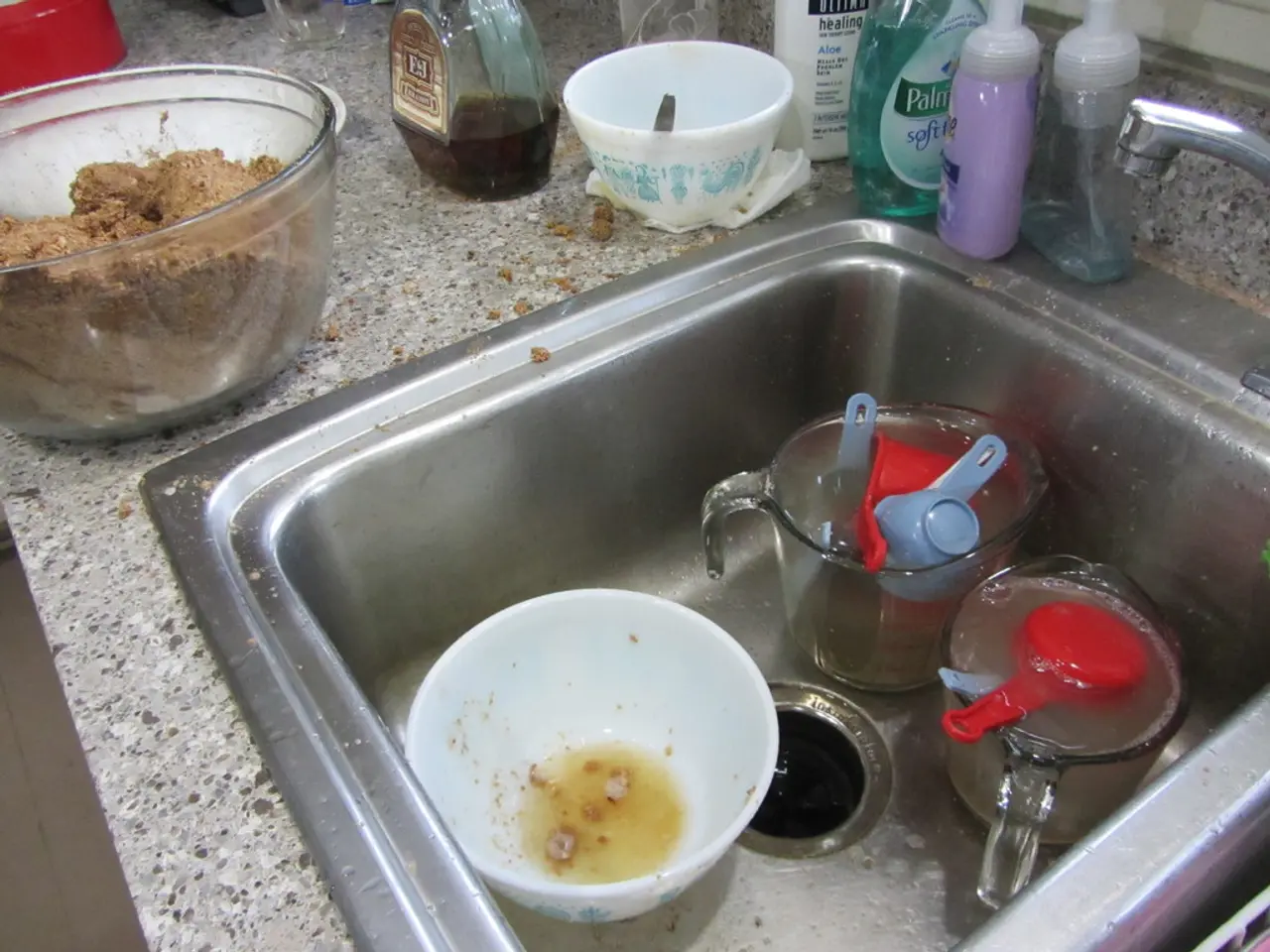Everyday Items Pose an Unseen Risk to Personal Well-being: The Stealthy Peril for Your Health
Creating a safer indoor environment is becoming increasingly important as research reveals that hidden toxins are widespread in everyday products. These toxins, often found in household items, beauty products, and processed food, can pose health risks over time.
Common Sources of Hidden Toxins
Hidden toxins can be found in a variety of everyday items. For instance, personal care products like shampoo, toothpaste, and nail polish may contain per- and poly-fluoroalkyl substances (PFAS), also known as "forever chemicals." These chemicals are also present in nonstick cookware and food packaging. Household items such as plastics release phthalates, which are hormone disruptors, while cleaning products and paints emit volatile organic compounds (VOCs) linked to respiratory issues and hormonal imbalances [1][2].
Furniture often contains flame retardants, and scented candles, air fresheners, and dryer sheets contribute to indoor air pollution [2][3]. In processed foods, additives, preservatives, and food packaging materials like BPA in plastic containers and canned goods leach toxins [2]. Additionally, kitchen items including soaps, baby products, and body washes can contain hidden hormone disruptors [4].
The Impact of Hidden Toxins
Exposure to these hidden toxins can lead to a range of health issues. Chronic fatigue, headaches, and unexplained muscle pain can be signs of hidden toxin exposure. Hidden toxins can cause respiratory issues such as inflammation of airways, allergic reactions, and chronic bronchitis, and can lead to hormonal disruptions [5].
Long-term exposure to hidden toxins can lead to serious health problems such as hormonal issues, respiratory challenges, chronic fatigue, allergy development, neurological system disorders, and potentially chronic illnesses including cancer [6].
Creating a Safer Indoor Environment
Fortunately, there are steps you can take to create a safer indoor environment. Air purifiers, houseplants, premium water purifying systems, staying inside and wearing filtering air masks when outdoor air quality exceeds permitted levels, organic non-toxic furniture and mattresses, low-VOC paints, and letting furniture vent before use are methods for creating safer indoor environments [7].
Switching to non-toxic household cleaners can help reduce exposure to hidden toxins. Regular exercise, sauna usage, intermittent fasting, and increased water intake can aid in natural body detoxification [8]. Opting for organic and minimally processed foods can help decrease contact with pesticides and food additives [2].
Natural body detoxification strategies include consuming detoxifying foods like leafy greens, garlic, turmeric, and lemon water. Plants like snake plants and peace lilies can help purify indoor air [9].
Minimizing Exposure to Hidden Toxins
To minimize exposure to hidden toxins, choosing non-toxic cleaning solutions, using candles made from beeswax or soybeans with natural scents, using BPA-free plastic containers, buying skin and beauty products made from organic ingredients, and avoiding mainstream hair products are some ways to do so [10]. Installing a high-quality water purification system can filter potential heavy metals and chlorine and fluoride substances from the water supply [11].
In conclusion, hidden toxins are dangerous chemicals found in various everyday products, including household items, beauty products, and processed food. By being aware of these hidden toxins and taking steps to reduce exposure, you can create a safer indoor environment and protect your health.
[1] Environmental Working Group. (2021). PFAS in Personal Care Products. Retrieved from https://www.ewg.org/pfas/pfas-in-personal-care-products
[2] Environmental Defense Fund. (2021). Hidden Toxins in Household Products. Retrieved from https://www.edf.org/health/hidden-toxins-household-products
[3] American Lung Association. (2021). Indoor Air Quality. Retrieved from https://www.lung.org/our-initiatives/healthy-air/resources/indoor/indoor-air-quality.html
[4] Natural Resources Defense Council. (2021). Chemicals of Concern. Retrieved from https://www.nrdc.org/issues/chemicals-concern
[5] American Cancer Society. (2021). Household Chemicals and Cancer. Retrieved from https://www.cancer.org/cancer/causes-and-prevention/risk-factors/household-chemicals.html
[6] National Institute of Environmental Health Sciences. (2021). Toxic Substances and Human Health. Retrieved from https://www.niehs.nih.gov/health/topics/agents/toxic-substances/index.cfm
[7] Environmental Protection Agency. (2021). Indoor Air Quality. Retrieved from https://www.epa.gov/indoor-air-quality-iaq
[8] Mayo Clinic. (2021). Detox diets: Do they work? Retrieved from https://www.mayoclinic.org/healthy-lifestyle/nutrition-and-healthy-eating/expert-answers/detox-diets/faq-20058429
[9] NASA. (2021). Indoor Plants for Air Cleaning. Retrieved from https://ntrs.nasa.gov/archive/nasa/casi.ntrs.nasa.gov/19930073137.pdf
[10] Environmental Working Group. (2021). Skin Deep® Cosmetics Database. Retrieved from https://www.ewg.org/skindeep/
[11] Water Quality Association. (2021). Drinking Water Contaminants. Retrieved from https://www.wqa.org/water-quality/drinking-water/contaminants
- Awareness about hidden toxins is crucial, as they are prevalent in everyday products like personal care products, cookware, and food packaging.
- PFAS, or 'forever chemicals', are harmful substances found in items such as shampoo, toothpaste, and nonstick cookware.
- Phthalates, hormone disruptors, are emitted by household plastics and cleaning products, linked to respiratory issues and hormonal imbalances.
- Flame retardants are often found in furniture, posing a risk to indoor air quality.
- Scented candles, air fresheners, and dryer sheets contribute significantly to indoor air pollution.
- BPA in plastic containers and canned goods leach toxins into processed foods.
- Kitchen items, such as soaps and baby products, may contain hidden hormone disruptors.
- Chronic fatigue, headaches, and unexplained muscle pain could be signs of hidden toxin exposure.
- Hidden toxins can cause respiratory issues like inflammation of airways, allergic reactions, and chronic bronchitis.
- Long-term exposure to hidden toxins can lead to serious health problems, including hormonal issues, respiratory challenges, and potentially cancer.
- Air purifiers can help create a safer indoor environment by removing pollutants and allergens.
- Houseplants, such as snake plants and peace lilies, can aid in purifying indoor air.
- Premium water purifying systems can filter potential heavy metals and harmful substances from the water supply.
- Opting for non-toxic household cleaners can reduce exposure to hidden toxins.
- Regular exercise can aid in natural body detoxification, along with sauna usage and intermittent fasting.
- Increased water intake can help flush out toxins from the body.
- Choosing organic and minimally processed foods can help decrease contact with pesticides and food additives.
- Consuming detoxifying foods like leafy greens, garlic, turmeric, and lemon water can support natural body detoxification.
- Natural body detoxification strategies can help protect against the impact of hidden toxins.
- Using candles made from beeswax or soybeans with natural scents can minimize exposure to hidden toxins.
- Opting for BPA-free plastic containers can help reduce the leaching of toxins into food and drinks.
- Buying skin and beauty products made from organic ingredients can help minimize exposure to harmful chemicals.
- Avoiding mainstream hair products can lead to lower exposure to hidden toxins.
- Installing a high-quality water purification system can help filter out potential harmful substances from the water supply.
- Hidden toxins are becoming increasingly important to address due to their wide presence in everyday products and their negative impact on health.
- Avoiding processed foods can help reduce contact with additives, preservatives, and harmful packaging materials.
- Creating a safer indoor environment requires awareness of the sources of hidden toxins and making intentional choices to limit exposure to them.
- Educational resources, such as the Environmental Working Group and the Environmental Defense Fund, provide valuable information about hidden toxins in everyday products.
- By making conscious choices about the products we use and the foods we eat, we can contribute to our overall wellness and reduce the impact of hidden toxins on our health.
- In the workplace, implementing 'workplace wellness' programs can help increase awareness of hidden toxins and promote the use of non-toxic alternatives.
- 'Health and wellness' initiatives focus on addressing the impact of hidden toxins on our overall health and well-being.
- Embracing a holistic approach to health and wellness, which includes mindfulness, personal growth, and self-development, can lead to increased awareness and reduced exposure to hidden toxins in everyday life.





